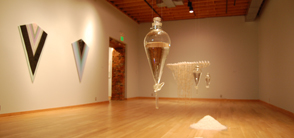Dynamic exhibits at Maryland Art Place, C. Grimaldis Gallery
By Tim Smith, The Baltimore Sun | October 6, 2011
Engaging, museum-level work fills two venues in Baltimore. Maryland Art Place has assembled a remarkable survey of minimalist painters from different areas and generations, while C. Grimaldis Gallery is offering a collection of pieces by five exceptional artists who produced work locally.
The Grimaldis show, "Five Maryland Icons," provides a richly varied experience — and, for those in the market, a fairly expensive one, with most of the pieces priced from $3,500 to $125,000.
Only one of the five "icons" included is still with us — Raoul Middleman, who started teaching at the Maryland Institute College of Art in 1961.
Middleman is represented here with several potent works, notably "Juliet of Eager Street," a large oil on canvas from 1982. The barefoot subject, attired in a 19th-century-style dress, stares rather blankly, her pose an intriguing contrast to the urban world behind her. The portrait makes quite a statement.
There is considerable communication as well in a group of landscapes by Middleman, whose bold brush strokes send fierce clouds rolling in "Impending Storm," an oil created this year.
Quietly vibrant examples of the venerable landscape genre are among the works by Baltimore-born Herman Maril in the show. His soft-edged colors and flat surfaces, somewhat David Hockney-esque in mood, produce their own kind of energy. "The Picnic," an oil from 1970 with wispy trees and simply drawn figures playing croquet, is a fine example.
Landscapes by Eugene Leake range from folk art-like items of the 1940s to the richly atmospheric "Night Bridge" from 1991. A beguiling, untitled oil on paper from around 1990 consists of two impressionistic landscapes, one placed above the other; each is painted in swirls of color that produce a strong vertical motion.
Leake's large-scale "Red Nude with Green Background" from the early '60s has a visceral edge.
Speaking of visceral, there's "Metamorphosis," a striking abstract by Keith Martin from 1963, with something of a protozoic shape that recalls Roberto Matta's surreal images. The richly shaded watercolor "Siren Song" from 1959 also shows off Martin's persuasive style.
A collection of works by prominent Maryland artists would have to include pieces by Grace Hartigan, and she is a commanding presence here. Selections include two large oils on the subject of Joan of Arc (one from 1996, appropriately for this exhibit, has something of an icon look), and, more imposing still, "Pale Horse Pale Rider," a masterful symphony of color and technique from 1991 that would, by itself, be worth a trip to Grimaldis.
Then there is "Painting in Parts" at Maryland Art Place, which exerts its own pull. Put together by consulting curator Michael Klein, the show is a good fit for the spacious galley.
Minimalism in art, typically viewed as a reaction to the complexity of abstract expressionism, tends to provoke strong opinions. Same for minimalism in music (personified by Baltimore-born Philip Glass), which offers a contrast to knotty atonality.
The MAP exhibit makes it easy to absorb pieces by 11 artists who have produced works that involve multiple parts. A prime example is "Dracula" (1972) by Don Dudley, consisting of 24 long, thin aluminum panels hanging vertically, black ones above white ones (more suggestive, perhaps, of piano keys than a vampire's overbite).
An untitled Tadaaki Kuwayama from 2000 fills a wall with a straight line of small, gold-shaded anodized aluminum squares. Daniel Buren's "Three Light Boxes for One Wall" from 1989 subtly illuminates a series of stripes to compelling effect.
There is a purity to such straightforward repetitions of familiar shapes, allowing the eye to drink in the essence of form and color. The process is at its most basic in Alan Charlton's "Solent" from 1985 — 30 individual, silver-colored strips, 87 inches by 7 inches, placed closed together.
A more vibrant example comes from a younger-generation minimalist, Luke Frost. His triptych "Supervolts No. 4" from 2010 produces an uplifting effect from rectangular panels in muted shades, each with a thin, contrasting stripe in the middle.
In each room of the gallery, "Painting in Parts" effectively underlines the longevity and power of minimalism.


.jpg)
.png)
.png)
